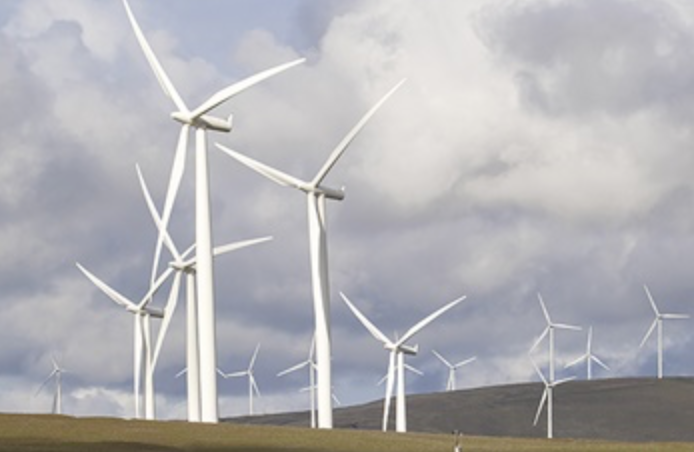By Camille Erickson
Casper Star-Tribune
Via- Wyoming News Exchange

CASPER — Onshore wind energy capacity in the U.S. has continued to climb, reaching over 100 gigawatts in 2019 — enough energy to power about 32 million homes.
Despite being a prime spot for wind development, the Equality State still doesn’t come close to leading the country in wind energy production. Just over 1,000 turbines are sprinkled throughout the state, providing 1,536 megawatts in online wind capacity.
But Wyoming wind enthusiasts have stayed hopeful all the same, and their optimism could pay off soon. Upward of 1,500 megawatts in new wind capacity could come online throughout state’s blustery plains this year, thanks in part to an impending year-end deadline to qualify for federal production tax credits.
That said, even a substantial expansion of the wind energy sector could not replace the state’s robust coal industry.
“Certainly wind development could offset some of the economic costs associated with the closure of coal-fired power plants and the decline in coal revenue,” University of Wyoming economist Rob Godby said. “The problem is is that the ongoing energy transition is going to cause a much larger reduction in revenue than any changes the state can offset.”
Wyoming exports over 90 percent of the coal it produces, making Wyoming’s revenue streams vulnerable to out-of-state customers’ fickle energy preferences.
According to the U.S. Energy Information Administration, coal production in Wyoming declined by 9 percent in 2019 compared to the year prior. The decline came in a large part due to the steady closure of coal-fired power plants nationwide.
“So, renewable energy presents a significant opportunity in Wyoming to diversify the economy,” Godby added. “But that said, the renewable energy sector is never going to be as large as the coal sector or the coal and natural gas sectors.”
Even so, more wind energy brings more jobs, tax revenue and economic activity. According to a University of Wyoming study, if existing tax rates stayed the same for wind energy over the next 20 years, current wind projects across Wyoming could bring in as much as $750 million in local taxes and $70 million in school finance revenues.
One of the more highly anticipated additions to wind energy includes the Chokecherry and Sierra Madre Wind Energy Project, a 3,000-megawatt wind farm, soon to boast 1,000 wind turbines in Carbon County. Power Company of Wyoming, the independent developer leading the project, plans to complete the wind farm as soon as 2023. It would be the largest wind farm the country has ever seen.
Construction began in earnest in September 2016. The company will resume building its turbine pads and network of roads this spring, as soon as the Bureau of Land Management tests the soil and finds conditions suitable for construction, said Kara Choquette, communications director for Power Company of Wyoming.
The project has already contributed approximately $2 million to local governments for impact assistance, a vast majority dedicated to Carbon County, based on October data from the Industrial Siting Division.
The project cleared a sizable hurdle in December when the Bureau of Land Management released its final environmental assessment. The federal agency approved an additional 396 wind turbines for the wind farm. Its decision brought the project’s entire site-specific environmental analysis (which launched in 2013) to fruition.
The state’s largest utility has also taken the lead in advancing renewable energy in Wyoming.
According to PacifiCorp’s 2019 integrated resource plan, the utility will install over 3,500 megawatts of wind generation capacity over the next three years, much of that destined for Wyoming.
PacifiCorp owns a dozen wind projects in Wyoming and has several power purchase agreements with companies overseeing 12 additional wind farms in the state, according to its most recent integrated resource plan.
What’s more, PacifiCorp’s Energy Vision 2020 — a $3 billion renewable energy initiative launched in 2017 — is also coming into the final stretch.
As part of its strategy, PacifiCorp’s TB Flats, Ekola Flats and Cedar Springs wind projects will come into service by the end of 2020, equipping the state with an additional 1,150 megawatts in wind generation capacity by the end of this year.
Utility companies saddled with the mandate to keep electricity reliable and prices low for consumers have been attracted to the increasing cost effectiveness of wind energy.
PacifiCorp also announced in August it would fully acquire the state’s first wind facility, Foot Creek I in Carbon County, as part of its plan to increase the site’s power capacity by 60 percent. The 69 turbines built in 1998 will eventually be replaced with 12 more efficient turbines.
One of PacifiCorp’s wind farms is being built by the renewable energy firm NextGen Energy Resources. The company is constructing wind farm Cedar Springs north of Douglas and Roundhouse west of Cheyenne. Both projects are expected to reach commercial operation by the end of 2020, according to Ryan Fitzpatrick, the project director.
“Construction is moving right along,” Fitzpatrick said Monday.
The crew even plans to start erecting wind turbines in the coming weeks at the Roundhouse site. Once in operation, the projects will create about 30 full-time wind technician jobs, he added.
As a Wyoming native, raised in Cheyenne, Fitzpatrick remains optimistic about the potential for wind in his home state.
“We are very excited about the future of wind energy development in the U.S., and I am personally excited for the next era for wind in Wyoming,” Fitzpatrick said. “ … There have certainly been obstacles in Wyoming, like there have been anywhere else in the country, but right now customers are interested in purchasing renewable energy and Wyoming has a great renewable energy resource.”
In addition, Wyoming’s Industrial Siting Council approved a permit for the Two Rivers Wind and Lucky Star Wind Energy Project on Nov. 20. The wind farms near Medicine Bow and Rock River will include as many as 277 turbines and eventually contribute upwards of 780 megawatts in total generation capacity. Construction of certain phases of the project will commence in April 2021, according to the agency.
Expanding wind energy in Wyoming comes with its challenges. As a wind farm produces electricity, it needs nearby transmission lines or infrastructure in place to transport the energy to customers. A lack of transmission lines in an area can slow or hinder development.
But multiple energy companies have started investing in an expanded network of transmission lines in Wyoming.
For one, PacifiCorp plans to energize its Gateway West transmission line in 2020, boosting Wyoming’s wind capacity by 750 megawatts. The 1,000-mile long line will snake from Wyoming to Idaho.
Chokecherry and Sierra Madre Wind Energy Project will also eventually flaunt a new transmission line. TransWest Express Transmission Project, a 730-mile line, would deliver power generated from wind to the Southwest and is scheduled for construction in 2020.
NextGen Energy also has a 19-mile transmission line in the works. It will transport wind energy from Roundhouse wind farm to Colorado’s Rawhide Energy Station in northern Colorado, according to the project director.
“We’ve always had the wind resource here, but transmission lines are expanding and that’s been a motivating factor to bring development back here,” Godby noted.
The decreased use of transmission lines by coal-fired power plants also opens up infrastructure to wind, he added.
Another challenge facing wind development comes down to technology: How do you build the most efficient, low-cost wind turbine that can compete with other energy sources?
To UW professor Jonathan Naughton, advancements in wind technology will also take center stage in 2020.One point of focus for engineers in 2020 will likely be improving the performance of wind turbines to “maximize productivity and minimize negative interactions between turbines,” Naughton explained. For years, the size of turbines has gradually expanded, along with innovations in nacelles, towers and blades. Often, these updates mean operators can install fewer wind turbines but generate more power.
But essential to any technological changes will be keeping the price of wind energy as low as possible, especially as the sinking price of solar energy poses competition to wind energy.
In addition, engineers will be working hard to integrate wind energy seamlessly into electrical grids that have relied for decades on conventional electricity sources, like coal, Naughton said. Wind energy has to be fully reliable and meet the intensive demand of the grid. When people reach for a light switch, they expect a light to come on in turn. But wind can be unpredictable.
“A lot of times we read that these challenges are impossible,” Naughton said. “I don’t think that that is true; I think that we have to get used to operating in a different way.”
The key to making the state attractive to wind developers includes reducing developers’ costs and increasing developers’ access to investment capital, according to Godby.
But Wyoming ranks fourth when it comes to the lowest cost for wind development in the West, trailing New Mexico, Montana and Colorado.
Once wind facilities have been up and running for three years, the state levies a $1 per megawatt wind generation tax, in addition to sales and property taxes. Lawmakers instituted the wind generation tax in 2012.
The state’s revenue committee has repeatedly raised the possibility of boosting the tax (six times since 2016). But none of the attempts have been successful.
To advocates of a wind tax, that additional revenue is critical, comparing it to the severance taxes placed on oil and gas companies. Raising the tax to $4 per megawatt would bring the state an additional $1.9 billion. But that assumes the higher costs do not repel developers, the Center for Energy Economics and Public Policy found. And taxing could come with consequences, according to several experts interviewed by the Star-Tribune.
“Within Wyoming, the way we tax probably handicaps us with respect to our relative attractiveness compared to other states,” Godby said. “… If we had a major taxation change, like some of those that have been suggested in the past, that could be significantly change our cost competitiveness with neighboring states.”
Like clockwork, state lawmakers revived the recurrent call to enact a state wind tax in September — this time on electricity generation more broadly. The bill did not advance to session.
“The point to be made is: If you are going to change taxes, be very careful about how you do it because it will have unintended consequences,” Godby said. “Don’t assume that development will continue on the same course it has been.”






